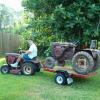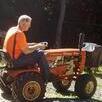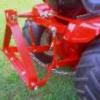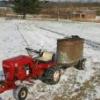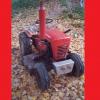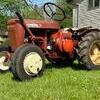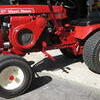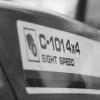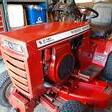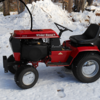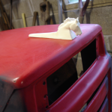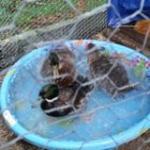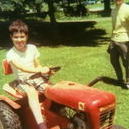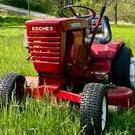Leaderboard
-
in all areas
- All areas
- Markers
- Marker Comments
- Marker Reviews
- Articles
- Article Comments
- Article Reviews
- Classfieds
- Classified Comments
- Classified Reviews
- Wiki's
- Wiki Comments
- Wiki Reviews
- Blog Entries
- Blog Comments
- Images
- Image Comments
- Image Reviews
- Albums
- Album Comments
- Album Reviews
- Files
- File Comments
- File Reviews
- Posts
-
Custom Date
-
All time
November 28 2011 - November 23 2024
-
Year
November 23 2023 - November 23 2024
-
Month
October 23 2024 - November 23 2024
-
Week
November 16 2024 - November 23 2024
-
Today
November 23 2024
-
Custom Date
02/19/2024 - 02/19/2024
-
All time
Popular Content
Showing content with the highest reputation on 02/19/2024 in all areas
-
13 pointsHere are some more three-wheel garden tractors. David Bradley Tri-Trac Unlike most 3-wheel garden tractors the Sears-Robuck David Bradley Tri-Trac rides on 2 front wheels and a single rear wheel. It was designed to pull a 1-bottom moldboard plow. Power is supplied by a Wisconsin AKND 6 hp engine. The 3 wheels and long wheelbase made it a bit unstable when turning, they compensated by installing front wheel weights which helped a little. The tractor had a forward and reverse variable speed transmission. Due to poor sales Sears began cutting prices. In its first year of production, 1954, the Tri-Trac was priced at $595 ($ 5,600 in 2024 money). A year later, the price dropped to $495; and in 1956 it dropped to $395 BOLENS HUSKI RIDEMASTER TRACTOR Although it has four wheels rather than three, the drive wheels are set so close together we may as well include the Ridemastere in this topic. In September of 1946, the Bolens Co. was purchased by the Food Machinery & Chemical Corporation (FMC) of San Jose, Calif. FMC already had a garden tractor named the Bean Cutler but renamed it the Bolins Ridemaster in 1947 because of the good reputation Bolins had established in the industry. Early models had no transmission and no gears. Instead, they featured a variable-speed belt system. Later Ridemaster models were built with forward, neutral and reverse gears and a two-speed transmission was offered on the Model 38AB. The Bean-Cutlers had a 5hp AKS Wisconsin engine. In 1949 the ridemasters were equipped with a 6hp BKN Wisconsin engine. These are models 35AA and 35AB. The 35AA had 4;00 x 18 drive tires. The 35AB had 6:00 x 16 drive tires. In 1956 a model 38AB came with an 8hp Briggs and Straton engine and Ride-a-matic, production ended in 1962. McLean Huskey The three-wheel McLean riding model called the Huskey was designed and put into production powered by a Briggs and Stratton Model 14 single cylinder air cooled engine. Since the Model 14 engine was produced from March of 1948 to November of 1963 it is difficult to pin down the years the Huskey would have been made. The Huskey had a single 5.00 X 12 agricultural rear drive wheel and two small solid rubber front tiers. The steering was a chain and sprocket design, there were no brakes and it had only one forward speed. The frame was made of ¾” pipe and there was very little in the way of sheet metal. @Achto probably can add some good information to the McLean history. Eshelman Kulti-Mower The Eshelman Kulti-Mower is a light duty riding tractor that can be a mower one minute and a cultivator the next. It was available in two sizes, 3 and 7 hp. The one pictured below is the 3 hp model. There wasn’t a great deal of additional information available on this tractor but the company and its owner are something else. More on that later. The Eshelman company began production of commercial light aircraft in Dundalk, MD after World War II, but was best known toward mid-century for its inexpensive light garden tractors which were widely promoted in small advertisements in the back pages of mechanical and scientific magazines from 1953 to 1961. Their line of garden tractors included one wheeled, two wheeled, three wheeled and four wheeled tractors and attachments for all. While searching for information about the Kulti-mower I found some intriguing information about Cheston L. Eshelman, the manufacturer and inspiration behind his line of garden tractors and so much more. I will share some of the particulars in another thread. Garden tractors were an important part of the mix but Eshelman also produced Micro-Cars, other vehicles and implements including motor scooters, pleasure boats, aircraft, golf carts, snowplows, trailers, mail-delivery vehicles and more.
-
9 pointsI’m picking up one tomorrow, don’t know much about them , my club cadet blew up last year , cost of new one is stupid, my stepfather has my grandpa wheelhorse that he bought new in 73-74 and it still run strong till this day , some day I’ll get it and restore both of them , I’m thinking that 400 ain’t bad in today’s market
-
8 pointsMoved a little further today. First thing was finishing up the weights for the front and drilling some holes in the front bracket in order to keep them in place. Pulled the head off from the engine and found a piston with a nice full coating of carbon on it. Given this pleasing find I may not pull the engine apart for a build up. The head will be getting shaved down though before I reinstall it. Next I pulled the oil pan in hopes of changing it out to an older wheel oil pan. That didn't work out but I will get back to that next. What I did find after removing the oil pan was a set of "grenade gears" (balance gears). These felt sloppy on the shafts, so I did what should be done with grenades - throw them as far away from you as you can. BTW, I was able to pull the grenade gears out without taking anything else apart on the lower end with the use of 90 degree snap ring piers and a flat screw driver. Was tricky finding just the right spot for the crank to be positioned in order to remove the gears. On to the next issue - I wanted to install an oil pan from an older to allow me to get rid of the shaker plate. The engine that I have has a different mounting base for the oil pan and will not allow the use of the older style pan. Plan B - I guess I'm running the shaker plate mount. On to another issue - the drain hole on this oil pan will not work with a shaker plate. Solution - Plug the original hole with a pipe plug and drill/tap a new hole in the correct position. I came to terms with the fact that I will need to run a shaker plate, but using the original rubber mounts was not to be in the cards. I had a set of aluminum solid mounts that were ear marked for another tractor, but decided to use them on my puller instead. These solid mounts work great!! Every thing lined up with very little trouble. One other bonus is that an older battery tray will still work with the shaker plate mount. Installed the battery tray with my new upgraded hold bar.
-
5 pointsSo I had a couple of decent caterpillar 657 cutting edges at work that I decided to bring home and make a box grader (BG). I welded everything up and added an electric lift actuator and a switch to lift and lower it. I works well but it is heavy and uphill pulls don’t go so well. Next is to fabricate a mid blade that can kick side to side like the factory mid blades but I’m going to also make it tilt side to side so I can grade my trail to have tilt for water sheeting.
-
5 pointsFound this old picture of me in my grandfather back in 1974 , my stepdad still has this wheelhorse , I’m hoping to get it this year , I know if I ask him he would give it to me , so I can restore both next fall
-
5 pointsI think you need one of these our township has one does all the crowning an swales on our dirt roads
-
5 pointsThis is very similar to what I've been working on. My current box blade works, but the fine adjustment isn't there. Yours is closer to what I'm gonna build.
-
4 pointsHeadline 30 years ago: Driven self starter decides to teach himself how a grader works for future endeavors. No injuries reported. Headline today: Child eco terrorist arrested during rampage. Parents questioned and detained. Neighbors describe harrowing incident and will receive counseling.
-
4 pointsCoach says in his wrestling tenure, only three freshman have qualified for state. Rylee is the first girl freshman he knows of from our school system making it through! She finished second at regionals, only to her upper classmen 1st place qualifier. Proud daddy!
-
4 points
-
4 points
-
4 points
-
3 pointsI got lucky one day and a Red [] member new that I was looking for one: He can chime in if he likes. Sent a pm and off I went to pick it up. All I did was use marvel to clean it up. Easy way to clean and bring back color. I think when at the factory they ran out of the side decals or the assembler put the wrong ones on. No big deal. The bonus of this is it is the same year as the tractor. And pretty much the same area in the state soooo you never know could be a set? Or not. I will hook it to the tractor one day to take a side shot Friday for Sparky. Hope you enjoyed the picks and the story.
-
3 pointsWow, that is really nuts. Let's hope that a second opinion is a better diagnosis. I'm not sure what my son-in-law's electrician and close friend had, but it was a form of leukemia. There were days when his lymph nodes under his arms were the size of apples. He continued to work and he continued his treatments, and vowed that each one was his last. He said no matter what, he was done with treatment, yet he'd decide to try one more, and here he is today, in full remission. There is always hope.
-
3 points
-
3 pointsSmall Three wheeled garden tractors The Hiller Yard Hand isn’t the only small three wheeled garden tractor. Here are a few more you may find interesting. Quaker Mule Earl Gate of Salem OH sold and manufactured accessories for the Roto-Tiller rear tine walk-behind tiller at his Gate Pump and Machine Company following World War Two. As the market for the Roto-Tiller became saturated with too many cheaper brands he decided it was time to build a simple sturdy riding garden tractor to fill a void in the market. The Quaker Mule garden tractor was powered by a single cylinder cast iron eight horsepower P-27 Lauson engine. The rear end and transmission appear to be from a model-A ford though I can’t confirm this. The tractor had turning brakes and a variety of well-crafted implements made by Gate. Production of the Quaker Mule began in 1947 and continued until 1958 Farm Imp The Farm Imp is powered by a Gladden Busy Bee engine. The engine pivots up to tighten the belts for forward and pivots down to a friction wheel clutch for reverse. The jackshaft passed power to an automotive differential and a speed reduction chain drive from it transmitted power to the rear wheels. The most unique feature of the IMP is the ability to move the front wheel to the right side so it and the right rear wheel will be in the furrow when you are plowing. Gladden Busey Bee engine Strunk Chipmunk Garden Tractor The Strunk Chainsaw Company branched out into the Garden tractor market for a couple of years. Located in Coatesville PA, they operated from 1943 to 1988 making great chainsaws. The Chipmunk Garden Tractor weighed only 75 pounds and was powered by a Strunk chainsaw two and a half horsepower engine with a centrifugal clutch and chain drive to the differential. Not likely to do much work but they sure look cute. Sears Craftsman 3-wheel lawn and garden Tractor In 1955 Sears needed a replacement for the Hiller tractor that had served them for the previous two years. A new Craftsman 3-wheeler powered by a Craftsman 2 hp, 2-stroke Power Products engine was selected. I didn’t find any information about the manufacturer. It was a single speed unit designed to pull a reel mower or small cart. It weighs only 110 lbs. The clutch lever connected to a belt tensioner allowed you to go forward, there was no reverse and brakes were optional. Bantam 14 3-wheel garden tractor In spite of their small size the Bantam 14 three-wheel garden tractors are ruggedly built little tractors. This small 1953 Bantam 14 is powered by a 5 hp engine and belt-driven transmission and has a hand-operated clutch. “The cast iron steering wheel was unique to the Bantam. Copar Panzer A 3-wheeler. The Panzer A has the same twin pipe frame found on other Panzer models. An eight horse power Briggs & Stratton Model 23 engine provided the power. The tractor didn’t have the latest transmission engineering. A graduated three pulley set of different diameters mounted on the engine and was connected by a belt to a corresponding set of pullies on a countershaft. To change speeds, you needed to shut off the engine, move the belt to another set of pullies and then proceed with your work, no too convenient! From the countershaft a chain drove the pinion of the differential on the narrowed Chrysler rear end fitted with 6.00 X 16 tires. The Pedals near the rear tires operate turning brakes; a friction disc puts the unit in reverse. About 350 of the three wheeled Model A were produced. We will cover even more three wheeled wonders tomorrow.
-
3 pointsI'd keep that seat and do a little repair on it. Tuck some patches underneath the tears with some good vinyl glue on them. They would close up pretty good where as you would hardly notice them.
-
3 pointsWOW to both of those unbelievable restorations and attention to detail. Thank you for those links @Zeek PS ,I have admired your work from many years ago. ,
-
3 pointsYes that is completely true, the Willys MB was both the inspiration for and basis of Rover motor cars entry into the 4x4 building arena. Maurice Wilks, the chief engineer at Rover, was the major driver for a new off road vehicke. During the particularly bad winter of 1947 the driveway to Maurice Wilks' house was blocked by snow. He borrowed a neighbours army surplus Jeep to ferry himself between the house and road. This vehicle was also used to plow snow and drag fallen trees off the drive after a huge storm. The amazing jeep convince Wilks that Rover should build their own version, a go anywhere vehicle that could do anything you wanted it to do. Two surplus jeeps were stripped and used for parts while the original one Wilks had borrowed and then swapped was used as the donor chassis for the first ever Land Rover vehicle; the Centre steer. This is it nearing completion in the jig shop at the Rover factory. Steering wheel in the centre, like a tractor which this was designed to copy. That also meant no left hand, right hand drive for all you chaps who insist on driving on the wrong side of the road lol. but it wasnt a practical idea and was ultimately dropped. The original prototype was dismantled and returned to being Wilks own Jeep until 1961, but this is a reconstruction of it showing exactly how it would have looked. From his first "Dream" of a go anywhere, do anything Rover to the first Land Rover in the factory yard took 9 months. An amazingly short time to develop a vehicle. It's a very, very complicated story though, with lots of factors caused by recovering from the 2nd world war and its fascinating to read about the problems and solutions that companies like Rover and Willys faced. This is me presenting the best book on Land Rover development to my book club as our next book of the month. The book club is a spin off from my yoga class, of which I am the only male member. Needless to say, the Land Rover book was not chosen by the majority lol.
-
3 pointsRemoved the plow. Didn’t get used much this season, but the couple of weeks it did, it got the job done. Normally Id mount the mower deck, but that responsibility is being taken over. So this one is gonna be pulling and plowing. Gave it a general clean up, touched up a couple scratches. Seats been cracked for a while now, so once the seat switch comes in for another seat I have, I’ll put that one on. Bummer though, cause this one has Wheelhorse emblem formed into it.
-
3 pointsNot today, as such. But a friend of mine took a photo of my brother and his wife, on his birthday in the summer of 2023 on an analogue camera and I love that it looks so timeless like it could be any time from the 70s to today
-
2 pointsk181 piston fits in bore but cover says k161 so may be bored out have been a horse lover long time over 50 tractors and lots of parts need help for my sicknes
-
2 pointsI have the mini…claims it does 4” to 12” wheels. I haven’t done any smaller than 6”. Ya still gotta put in some grunt to get it done but I have swapped out 100’s of tires over the years with this one. Pretty sure I paid $24.99 for it brand new
-
2 pointsLike most early garden tractor companies, McLean started out with 2 wheel tractors. With electricity becoming more available people were switching their Maytag wash machines over to electric motors. McLean would buy up any Maytag engine that they could. They would then rebuild these engines and use them on their 2 wheel walk behind tractors. Next Mclean started building 4 wheel tractors like the one that I restored / built from scratch. 2 speed trans + reverse, no brakes. Their last model was the McLean Husky Big wheel. I have found a couple of these for sale but the timing was off for me. No brakes on the Big Wheel either. Not sure what they had against being able to stop.
-
2 pointsIf you want to save the tire to use with a tube just take it to a local indy tire shop. They can pop that thing off so easy with the power changers they use. Had to do that with one of my GT 14 rears. I have both HF tire tools and use them both but sometimes it just makes sense to let the pro's make quick easy work of it.
-
2 points
-
2 points
-
2 pointsWe mounted ours near the top of the seat back to get a good angle and spread. We wired them inside under the seat cushion and out the bottom to a two-conductor bullet connector. Power is from the rear lights with an extra switch so rear light is on only when needed.
-
2 pointsYou get to using that tractor and you'll love it more and more each time. This old iron doesn't even compare to the new stuff.
-
2 points
-
2 pointsI would call A-Z and ask when he will have more. That stock level may not be accurate
-
2 pointsI do like the under mounting set up. Nice clean look. Bright idea.
-
2 points
-
2 points
-
2 points
-
2 pointsDon't recall ever seeing an ignition switch with a M and an I terminal. Could the I possibly be an R or A?
-
2 pointsWow you got the goal done for the day! We didn't know if the grenades could be removed without pulling the crank but yes it can be. Dan pulling them ...it is a bit tricky. I know where to get more... little bird told me Lowell may be selling them.
-
2 pointsThe likelihood is that a wire terminal or fuse holder is corroded and needs to be cleaned. Most of the wiring lives near the battery and over time the acid fumes from the battery being charged will take a toll on wiring connections. I have attached a wiring guide link that may be helpful.
-
2 pointsBelow is a link to the wiring your tractor would have had leaving the factory. If your tractor is performing well and all you wish to do is add the LED lighting there are a couple of options. If the wiring is as shown in the drawing and the light switch has an Orange wire running to it just use that as a power feed. From the sound of your wiring to the ignition switch it may have been rewired with an incorrect switch. If that is the case you could connect a wire to the battery "+" terminal with a 10 Amp fuse, switch and then on to the lights.
-
2 points
-
2 pointsI'd be strong for late 70’s but dress shoes and jeans was more 80’s. 😄
-
2 pointsII just attached lift to the deck lift point using a latered model lift chain.. I have 19 x 7 x 8 tires on front had to pull the deck back, they hitting the deck when I turned sharp. Once pulled back it stayed back. My mid hitch bolted right up all three holes were there. The old 12 Kohler is a little low on power, didn't like that 42" deck, still runs good and doesn't smoke. But then mowing I use a 1989 520-H and my C-120/180 with a 18 HP Briggs Vanguard so it's not quite what I'm use to.
-
2 pointsExcellent work in both cases and really inspiring examples to look at. I bet those tractors are gonna be around for another 50 years
-
2 points
-
2 pointsThis is really handy, bit bulky, but i find myself laying it on the bench upside down and using it to clean parts when i cant clamp them in a vice..it leaves a really smooth finish.
-
2 pointsi don't want to be overly optimistic but you may have rescued me from sleepless nite -- haha - - per your suggestions - i loosened multiple tin screws and sounds like the whine is gone -- its dark and cold out so i will wait till tomorrow to declare victory --- So tomorrow i will have light and warmer temps and will see if that was the issue and solution??? Let's hope???????????? As always the members here are always on stand by -- many thanks -- stay tuned for tomorrow's follow up -- thanks, Bill
-
2 pointsRust-Oleum=birth control! Same for old gear oil! And if you really wanna make the ladies angry, just mix up some body filler skim coat!
-
2 pointsi bought two c175s at same time couple yrs ago -- the Series 1 had tins -- this Series 2 had no tins --- i was able to acquire the matching tins separately - - and fortunately i had the other KT17 on the other C175 to mirror the install application and do a copycat to see the tin alignment and screw bolts placement ---- etc -- so i cleaned the tins I acquired and then sprayed with high temp primer and paint - - came out looking good -- but when i did the new strarter motor install and few other tasks over past couple weeks, it also invloved some tins - - So i am hoping its something simple like the tins and certainly hoping its not internal to the engine???????? i've done lots of work on this tractor so I don't want to go backwards with new issues !!! UGH !!
-
2 pointsGentlemen, Today I reinstalled the head on the ‘69 Charger 12 complete with a new gasket, spark plug and bolts. There’s something about shiny new hardware that really gives me the fizz. Anyone else?
-
2 points

